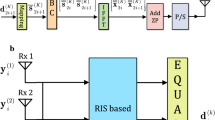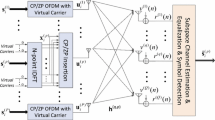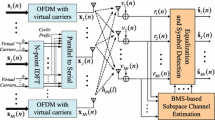Abstract
Fast blind subspace channel estimation using circular property of the channel matrix is investigated for space–time block coded (STBC) multiple-input multiple-output orthogonal frequency division multiplexing (MIMO–OFDM) systems in this paper. The noise subspace computed from the correlation matrix of received signals requires a large number of symbols to converge in the subspace channel estimation. Using the circular property of the channel matrix, we propose both the cyclic repetition method (CRM) and the forward–backward method (FBM) to generate N times of equivalent signals for each STBC–OFDM symbol, respectively, where N is the size of FFT operation. With these equivalent symbols, the proposed CRM, FBM and CRM–FBM (CFBM) channel estimations can perform very well within a few OFDM symbols. The CRM, FBM and CFBM schemes are applicable to the CP-OFDM, ZP-OFDM and VC-OFDM systems, respectively. The identifiability of the subspace channel estimation is investigated that the channel matrix is determined up to two ambiguity matrices. Computer simulations demonstrate that the CRM-based, FBM-based and CFBM-based channel estimations have better performances than the conventional ones.









Similar content being viewed by others
References
Sibille, A., Oestges, C., & Zanella, A. (2010). MIMO from theory to implementation. New York: Academic Press.
Larsson, E., Edfors, O., Tufvesson, F., & Marzetta, T. (2014). Massive MIMO for next generation wireless systems. IEEE Communications Magazine, 52(2), 186–195.
Lu, L., Li, G., Swindlehurst, A., Ashikhmin, A., & Zhang, R. (2014). An overview of massive MIMO: Benefits and challenges. IEEE Journal of Selected Topics in Signal Processing, 8(5), 742–758.
Jiang, M., & Hanzo, L. (2007). Multi-user MIMO–OFDM for next generation wireless systems. Proceedings of the IEEE, 95(7), 1430–1469.
Boccardi, F., Clerckx, B., Ghosh, A., Hardouin, E., Jongren, G., Kusume, K., et al. (2012). Multiple antenna techniques in LTE-advanced. IEEE Communications Magazine, 50(3), 114–121.
Stüber, G. L., Barry, J. R., McLaughlin, S. W., Li, Y., Ingram, M. A., & Pratt, T. G. (2004). Broadband MIMO–OFDM wireless communications. Proceedings of the IEEE, 92(2), 271–294.
Tarokh, V., Seshadri, N., & Calderbank, A. R. (1998). Space–time codes for high data rate wireless communications: Performance criterion and code construction. IEEE Transactions on Information Theory, 44, 744–765.
Alamouti, S. M. (1998). A simple transmit diversity techniques for wireless communications. IEEE Journal on Selected Areas in Communications, 16, 1451–1458.
Jafarkhani, H. (2005). Space–time coding: Theory and practice. Cambridge: Cambridge University Press.
Tirkkonen, O., & Hottinen, A. (2002). Square-matrix embeddable space–time block codes for complex signal constellations. IEEE Transactions on Information Theory, 48, 384–395.
Luo, L., Zhang, J., & Davis, L. M. (2012). Space–time block code and spatial multiplexing design for quadrature-OFDMA systems. IEEE Transactions on Communications, 60(10), 3133–3142.
Li, H., Ho, C. K., Bergmans, J. W. M., & Willems, F. M. J. (2008). Pilot-aided angle-domain channel estimation techniques for MIMO–OFDM systems. IEEE Transactions on Vehicular Technology, 57(2), 906–920.
Liu, Y., Tan, Z., Hu, H., Cimini, L. J., & Li, G. Y. (2014). Channel estimation for OFDM. IEEE Communications Surveys & Tutorials, 16(4), 1891–1908.
Gao, F., Zeng, Y., Nallanathan, A., & Ng, T. S. (2008). Robust subspace blind channel estimation for cyclic prefixed MIMO OFDM systems: Algorithm, identifiability and performance analysis. IEEE Journal on Selected Areas in Communications, 26, 378–388.
Gong, Y., & Letaief, K. B. (2003). Low complexity channel estimation for space–time coded wideband OFDM systems. IEEE Transactions on Wireless Communications, 2, 876–882.
Tu, C.-C., & Champagne, B. (2009). Subspace-based blind channel estimation for MIMO–OFDM systems with reduced time averaging. IEEE Transactions on Vehicular Technology, 59(3), 1539–1544.
Sarmadi, N., Shahbazpanahi, S., & Gershman, A. B. (2009). Blind channel estimation in orthogonally coded MIMO–OFDM systems: A semidefinite relaxation approach. IEEE Transactions on Signal Processing, 57(6), 2354–2364.
Zhang, H., Yuan, D., Chen, H., & Nossek, J. (2009). Effects of channel estimation error on array processing based QO-STBC coded OFDM systems. IEEE Communications Letters, 13(4), 212–214.
Zeng, Y. H., Lam, W. H., & Ng, T. S. (2006). Semi-blind channel estimation and equalization for MIMO space–time coded OFDM. IEEE Transactions on Circuits and Systems I: Regular Papers, 53(2), 463–474.
Yu, J. L., & Lin, Y. C. (2009). Space–time coded MIMO ZP-OFDM systems: Semi-blind channel estimation and equalization. IEEE Transactions on Circuits and Systems I: Regular Papers, 56(7), 1360–1372.
Kim, J. G., Oh, J. H., & Lim, J. T. (2012). Subspace-based channel estimation for MIMO–OFDM systems with few received blocks. IEEE Signal Processing Letters, 19(7), 435–438.
Zhang, B., Yu, J. L., & Lai, J. W. (2014). A fast subspace channel estimation for STBC-based MIMO–OFDM systems. In Proceedings of the eleventh international symposium on wireless communication systems (ISWCS), Barcelona, Spain, pp. 26–29.
Vershynin, R. (2012). How close is the sample covariance matrix to the actual covariance matrix? Journal of Theoretical Probability, 25(3), 655–686.
Gray, R. M. (2006). Toeplitz and circulant matrices: A review. Boston: Now Publishers.
Giannakis, G. B., Hua, Y., Stoica, P., & Tong, L. (2001). Signal processing advances in wireless and mobile communications (Vol. 1). Englewood Cliffs, NJ: Prentice-Hall.
Acknowledgments
This work was supported by the Ministry of Science and Technology, Taiwan under Grants MOST-104-2221-E-030-004-MY2, the National Natural Science Foundation of China under Grants No. 61501041, the Open Foundation of State Key Laboratory under Grants No. ISN16-08, the Special Foundation for Young Scientists of Quanzhou Normal University of China under Grants No. 201330 and Fujian Province Education Department under Grants JA13267.
Author information
Authors and Affiliations
Corresponding author
Appendices
Appendix 1: Proof of Lemma 1
We note that \(\mathbf{G}\) and \(\mathbf{H}\) have the same rank for \(\mathbf{P}_{2N,M_\mathrm{r}} \) and \(\mathbf{Q}_{2N,K} \) are orthogonal matrices. Since G is a block circular matrix, it is diagonalizable by DFT/IDFT matrix,
where \(\mathbf{F}_{N,M} =\mathbf{F}_N \otimes \mathbf{I}_M \) and \(\varvec{\Lambda }_G (k)\) is the kth frequency response of \(\{\mathbf{g}(n)\}\). From (11), \(\varvec{\Lambda }_G (k)\) is obtained as
From (62), G and H are of full column rank if and only if \(\varvec{\Lambda }(k)\) has full column rank for \(k = 0, {\ldots }, N-1\), which proves this lemma.
Appendix 2: Proof of Theorem 2
Since both H and \({\hat{\mathbf{H}}}\) are of full column rank and \(span(\mathbf{H}) = span({\hat{\mathbf{H}}})\), we have \(\mathbf{H} = {\hat{\mathbf{H}}{} \mathbf{A}}\) where A is a \(2KN\times 2KN\) nonsingular matrix. Applying (13) to both H and \({\hat{\mathbf{H}}}, \mathbf{H} = {\hat{\mathbf{H}}{} \mathbf{A}}\) is simplified as \(\mathbf{G} = {\hat{\mathbf{G}}{} \mathbf{B}}\) where \(\mathbf{B}=\mathbf{Q}_{2N,K}^T \mathbf{AQ}_{2N,K} \). Besides, similar to \(\mathbf{G}\) in (63), \({\hat{\mathbf{G}}}\) can be diagonalizable by \({\hat{\mathbf{G}}}=\mathbf{F}_{N,2M_r }^H {\hat{\varvec{\Lambda }}}_G \mathbf{F}_{N,2K} \). Then we have
where C is a \(2NK\times 2NK\) matrix. Since \(\varvec{\Lambda }_G \hbox { and }{\hat{\varvec{\Lambda }}}_G \) are block diagonal matrices, we can find that C is also a block diagonal matrix with \(\mathbf{C}=diag\left( {\mathbf{C}_{0,0} \cdots \mathbf{C}_{N-1,N-1} } \right) \) where \(\mathbf{C}_{n,n} \) is a \(2K\times 2K\) matrix. Therefore, matrix B becomes
It is known that a circular matrix can be diagonlizable by the DFT/IDFT matrix, and vice versa. Therefore, matrix B is rewritten as a block circular matrix where the first 2K row vectors are composed by \([\mathbf{B}_{0}{} \mathbf{B}_{1} {\ldots }\mathbf{B}_{N-1}]\) and where \(\mathbf{B}_n ,n = 0,\ldots ,N-1\) is a \(2K\times 2K\) matrix. Using \(\mathbf{G}={\hat{\mathbf{G}}{} \mathbf{B}}\) and B is a block circular matrix, the equations for which the entries in \(\mathbf{G}\) are zeros are given by
where \(\mathbf{T}_{toe} ({\hat{\mathbf{g}}})\) is a \(2M_r (N-L-1)\times 2(N-1)K\) block Toeplitz matrix constructing by \({\hat{\mathbf{g}}}=\left[ {{\hat{\mathbf{g}}}(0)\cdots {\hat{\mathbf{g}}}(L)} \right] \). With the assumption that \({\hat{\mathbf{G}}}(z)\) is irreducible, the matrix \(\mathbf{T}_{toe} ({\hat{\mathbf{g}}})\) is of full column rank [25] and \(\mathbf{B}_i =\mathbf{0}\) for \(i = 1,2,\ldots ,N-1\). Then the matrix \(\mathbf{B}\) is simplified as \(\mathbf{B} = \mathbf{I}_N \otimes \mathbf{B}_0 \). It turns out that \(\mathbf{G}={\hat{\mathbf{G}}{} \mathbf{B}}\) becomes
Let \(\mathbf{B}_0 =\left[ {{\begin{array}{ll} {\mathbf{b}_1 }&{} {\mathbf{b}_3 } \\ {\mathbf{b}_2 }&{} {\mathbf{b}_4 } \\ \end{array} }} \right] \) where \(\mathbf{b}_i \in C^{K\times K}\). Considering \(n = k\) and \(n = L-k\) in (68), we obtain
Since we assume \({\hat{\mathbf{h}}}(0)\) is of full column rank, we have \(\mathbf{b}_4 =\mathbf{b}_1^*\) and \(\mathbf{b}_3 =-\mathbf{b}_2^*\). Using these equalities, the proof of Theorem 2 is complete by simplifying (68) into (20).
Rights and permissions
About this article
Cite this article
Zhang, B., Yu, JL., Yuan, Y. et al. Fast blind channel estimation for space–time block coded MIMO–OFDM systems. Telecommun Syst 65, 443–457 (2017). https://doi.org/10.1007/s11235-016-0244-5
Published:
Issue Date:
DOI: https://doi.org/10.1007/s11235-016-0244-5




